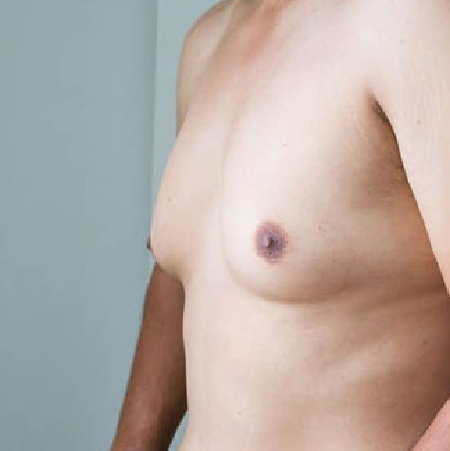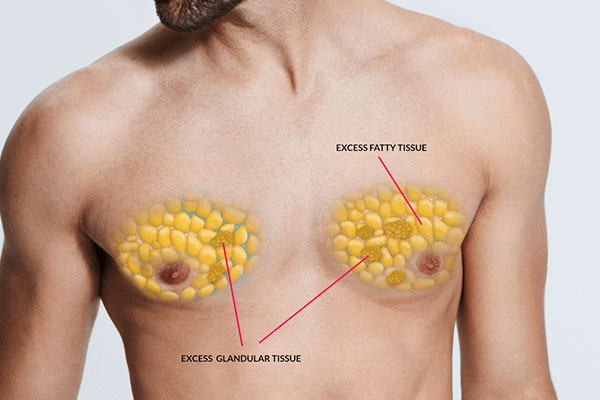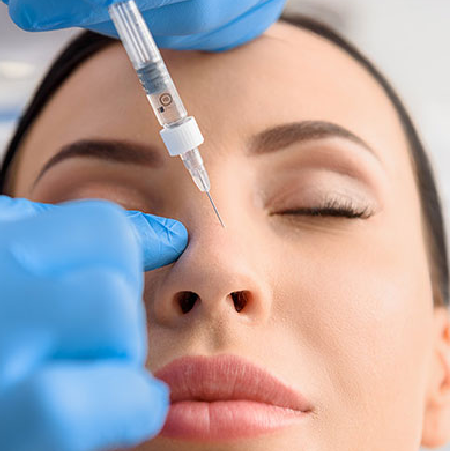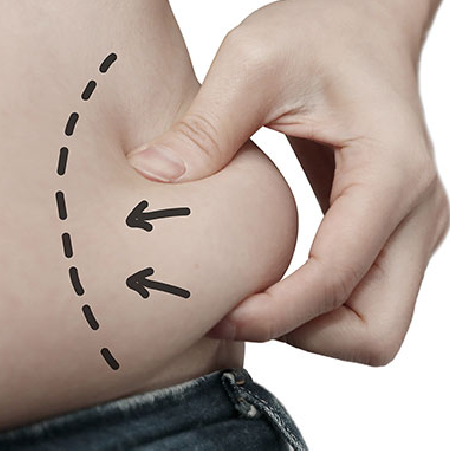Recovery after Gynecomastia Surgery

Recovery from gynecomastia surgery is different for each person, depending on the extent of the treatment and their health. Here is an overview of what you can expect during recovery:
Immediately after an operation:
After the surgery, you’ll be taken to a healing area where you’ll be closely watched. People often feel groggy, tired, or sore. Your scars may have dressings or bandages on them, and you may be wearing a support garment to keep swelling down and keep the shape of your chest while it heals.
The first couple of days:
During the first few days after surgery, you should rest and get better. You might have some pain, swelling, and bruises, but you can take medicine to help. During this time, you should avoid doing anything hard, like lifting big things or working out.
The First Weeks:
During this time, the swelling and bruises should slowly go away. Depending on your job or hobbies, you’ll probably be able to go back to work or school after a week. As your doctor told you, you should keep wearing the compression device for a few weeks.
One month later:
By now, most of the swelling should have gone down, and you should be able to see how your chest has changed. But the growth may still be there for a few months. Around this time, you should be able to do normal things and exercise again, but always do what your therapist tells you to do.
Recovery Over Time:
Most of the time, the final effects of gynecomastia surgery can be seen three to six months after the swelling has gone away. Over time, the scars from the cuts will also fade.
Be sure to carefully follow your surgeon’s advice to make sure your recovery is safe and goes well. This means taking the medicines your doctor gives you, taking care of the place where the surgery was done, and going to all of your follow-up appointments. Even though the above gives a general timeline, everyone heals at their own pace, so recovery times can change. Always ask your doctor or surgeon for information that is specific to you.
Read more: Gynecomastia surgery in Iran
care of patients AFTER gynecomastia surgery
After gynecomastia surgery, it’s important to pay attention to a few things:
Taking care of pain: It’s normal to feel some pain and soreness after surgery. Most of the time, the surgeon will give you pain medicine. Make sure the patient does what the instructions say.
Care for Wounds: The area around the surgery should be kept clean and dry. The doctor should tell you how to wear any bandages or tight clothing to help reduce swelling and speed up healing.
Mobility: Tell the patient to take short walks around the house to help the blood flow and keep blood clots from forming. But the surgeon will tell you to avoid strenuous tasks and heavy lifting for the first few weeks of recovery.
Make sure the patient stays refreshed and eats a healthy, well-balanced diet. Getting the right food is important for getting better.
Sleep Position: For the first few weeks, the patient should sleep on their back with their head slightly raised. This will help reduce swelling.
Follow-Up visits: Make sure the patient goes to all of their follow-up visits so the surgeon can check on how well they are healing and deal with any problems right away.
Support on an emotional level: Going through surgery can be stressful. Giving the patient mental support and reassurance can help them get through the time after surgery when they are recovering.
Always do what your doctor tells you to do after surgery, and call them right away if you notice any signs of infection or other problems, like a fever, more pain, or a strange discharge from the surgical site. Remember that every patient’s path to healing is different, and care should be based on what they need.

What happens before gynecomastia surgery?
Before gynecomastia surgery, there are a few things that need to be done:
Consultation with a doctor: At first, you’ll meet with the operator for a talk. The doctor will look at your medical background, talk to you about your symptoms, and do a physical exam. This may also include tests like blood tests, mammograms, or ultrasounds to prove gynecomastia and rule out other conditions.
Discussion of Possible Treatments: If surgery is suggested, your doctor will talk to you in detail about it, explain the possible risks and benefits, and answer any questions you may have. Depending on your situation, you might have liposuction, a mastectomy, or a mix of the two.
Instructions before the surgery: You’ll get clear advice on how to get ready for the surgery. These may include rules about what to eat, drink, and how to take medications. For example, you might be told to stop taking some medicines that can make you bleed more. If you smoke, you’ll be told to stop well before the surgery because it can slow down your recovery.
Preoperative exam: Before surgery, you’ll have a preoperative exam to make sure you’re in good health. This could involve an EKG, a chest X-ray, or other tests in the lab. An anesthesiologist will also check you out so they can talk to you about anesthesia.
Informed Consent: Finally, you’ll need to sign a consent form that says you understand the process, its possible risks and benefits, and agree to go through with the surgery. Remember that it’s important to carefully follow all pre-operative instructions to make sure the process goes well and reduce the risk of problems. Talk to your doctor or nurse for information that is specific to you.
Read more: How to sleep after gynecomastia surgery
Recovery time after getting gynecomastia surgery?
The length of time it takes to heal from gynecomastia surgery depends on how extensive the operation was and how each person heals. But here is a broad timetable:
1-2 Weeks After Surgery: Depending on the nature of their job, most people can go back to work and do their daily tasks within one to two weeks after surgery. During this time, you shouldn’t do hard work or lift big things.
3–4 Weeks After Surgery: Patients may be able to return to more strenuous physical activities, such as exercise, after 3–4 weeks, based on their surgeon’s advice and how well they are healing.
Several Months After Surgery: The final result of the surgery, in which the chest looks more shaped and flat, can often be seen several months after the process. This gives the area where the surgery was done time to fully heal and the swelling to go down.
During recovery time, patients need to do everything their surgeon tells them to do. This could include taking care of wounds, wearing a compression garment, dealing with pain or discomfort, and going to follow-up appointments. Keep in mind that these are just general predictions and that each person’s recovery time may be different. Talk to your doctor or nurse for information that is specific to you.
Gynecomastia Surgery Recovery Tips
Getting better after gynecomastia surgery takes time and care. Here are some tips to help you get better:
Follow the instructions of your surgeon: This is important. Your surgeon knows the most about your situation and gives you directions based on that. This includes taking care of the wound, the amount of activity, the use of a compression garment, and follow-up visits.
Take it easy and rest: Give your body time to get better. For as long as your doctor tells you, don’t do anything hard or lift anything big.
How to Take Care of Pain: Use the pain medicine as your doctor tells you to. Don’t try to tough it out, because pain that can’t be managed can slow your healing.
Put on your compression clothing: This makes the swelling go down and helps the mending tissues. Wear it as often as your doctor tells you to.
Stay hydrated and eat a balanced diet: Staying hydrated and eating well can help you get better. Focus on eating a well-balanced diet that is full of energy and vitamins. This can help you get better faster.
Don’t smoke: Smoking can slow down the healing process and make problems more likely. If you smoke, you should try to quit or at least stop for a few weeks before and after surgery.
Follow-up appointments should all be kept: With these visits, your surgeon can check on your recovery and catch any problems before they get worse.
Sleep in the Recommended Position: To keep swelling down in the first few weeks, you should sleep on your back with your head slightly raised.
Taking care of your mental health is important: Getting better after surgery can be an emotional process. It’s normal to feel sad or restless, but try to stay upbeat and remember that healing takes time.
Remember that the way each person gets better is different: Always ask your doctor or surgeon for information that is specific to you.

FAQs
How long does it take to get back to normal after surgery for gynecomastia?
How long it takes to fully recover from gynecomastia surgery usually depends on how extensive the operation was and how healthy the person is. Most people can go back to work that isn’t too hard one to two weeks after surgery, and after about a month, they can do normal physical activities like exercise again. Most big swelling goes away in a few weeks to a month, but small swelling and the settling of tissues can go on for three months or longer. About six months to a year after surgery, the final effects of the surgery, including the fading of scars, can be seen. Always keep in mind that these times are just estimates and that each person’s healing time may be different. For a good recovery, it’s important to do exactly what your surgeon tells you to do after surgery.
How can I get better faster after surgery for gynecomastia?
Getting better faster after gynecomastia surgery means doing a few key things. First, do exactly what your doctor tells you to do after surgery. Taking care of wounds, having a compression garment, dealing with pain, and going to follow-up appointments are all part of this. Second, your doctor will tell you to get a lot of rest and stay away from things that are too hard on your body. Keep a healthy diet, stay hydrated, and don’t smoke, which can slow down the healing process. Last, take care of your mental health. A cheerful attitude can help the healing process in a big way. Remember that these steps can help people get better, but everyone heals at a different pace, so waiting is key. Always ask your surgeon for the help that is right for you.
Does gynecomastia make the fat come back?
After surgery for gynecomastia, the extra glandular tissue that was taken out will not grow back. But if a person gains a lot of weight, uses steroids, or has certain medical conditions, fat and possibly glandular tissue can build up in the chest area again. This could make the person look like they have breasts again. The best way to prevent the effects of gynecomastia surgery is to maintain a stable weight through a healthy diet and regular exercise. It’s also important to stay away from things that could mess with your hormones and cause gynecomastia. Remember that each person’s effects can be different, and it’s important to talk to your surgeon about your hopes and worries.
What not to do after surgery for gynecomastia?
There are a few things you should not do after gynecomastia surgery to make sure you heal well. Don’t do strenuous tasks, heavy lifting, or intense exercise for as long as your doctor tells you to, which is usually at least 3–4 weeks. Don’t smoke or drink alcohol because it can slow down the healing process. Don’t ignore what your surgeon tells you to do about taking care of your wounds, wearing a compression garment, and taking medicines. Don’t sleep on your stomach or side until your doctor says it’s safe to do so. Lastly, don’t ignore any signs of problems, like a high fever, more pain, or a strange discharge from the wound site. If you notice any of these, you should call your doctor right away.
Why is my chest so tight after gynecological surgery?
After gynecomastia surgery, it is common for the chest area to feel hard. This is usually a normal part of the healing process. Scar tissue and swelling are typically the causes of this stiffness or hardness. Your body reacts to the process by making the area swollen, which can make it feel hard or lumpy. This firmness generally goes away over time, usually in the months after surgery, as the swelling goes down and the scar tissue softens and changes. But if the hardness lasts for a long time or is accompanied by pain, redness, or an increase in swelling, it’s important to talk to your surgeon or a medical professional to rule out problems like hematoma or seroma.











